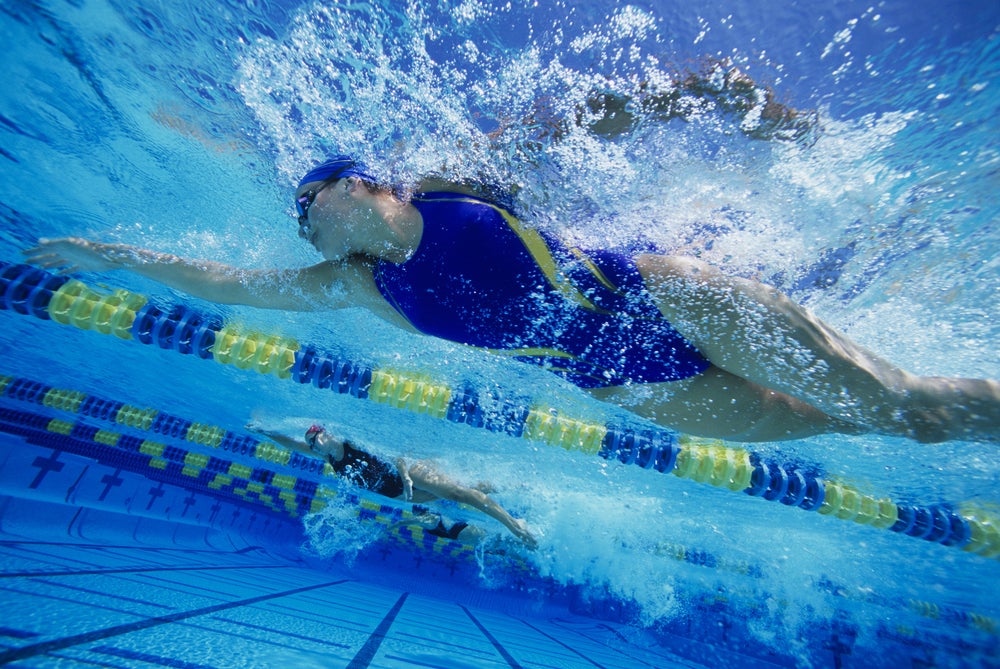The Five Phases Of Swim Training

A triathlete does an epic aerobic set in the pool during a Weekend Swim Workout. (Photo: Shutterstock)
Swim coach Sara McLarty explains why it’s important to vary your training throughout the year.
Are your swim splits always the same? Perhaps it’s because your swim training is always the same. Swim practice should change multiple times during the year. There are five phases of swim training: endurance, strength, speed, taper and recovery. For the best results on race day, spend some time focusing on each phase.
How much time is a question that can only be answered on an individual basis and must also consider the triathlete’s ability level and the competition’s distance. A year-round athlete will spend two to three months in a phase while a first-timer might only spend a few days. Sprint athletes emphasize the speed phase while iron-distance athletes spend more time on endurance.
The Phases
A typical triathlete, with “A” races in early June and September, will be used for the following examples. The interval times used in the example assume an athlete whose normal 100-yard pace is roughly 1:40. Adjust the times as appropriate to fit your pace.
1. The endurance phase of swim training usually starts after the winter holidays or at the beginning of the New Year. This is typically when races open registration and athletes realize that it’s time to start training. Between the months of January and March, focus on building (or rebuilding) endurance. Training sets should be long, and the effort level should be moderate. Break the monotony of workouts with equipment and creative sets.
For example:
600 warm-up (200 swim / 200 kick / 200 drills)
9 x 200 freestyle with 30 seconds rest (3 with fins, 3 pull, 3 swim)
100 easy
RELATED: The 4 Phases Of The Freestyle Swim Stroke
2. In the strength phase, the pace clock becomes very important and the intervals become challenging. Starting in late March and continuing through April, include a strength set in two-thirds of weekly swim practices. Knock off five or 10 seconds from your regular send-off-interval and try to descend times (i.e. swim faster and faster splits) all the way through a set with a large number of intervals. Use pulling equipment during the main set to build upper body strength.
For example:
600 warm-up (2 X 200 swim / 50 kick / 50 drill)
6 x 50 freestyle at 1:00 (descend 1-3, 4-6)
15 x 100 freestyle (5 at 2:00, 4 at 1:55, 3 at 1:50, 2 at 1:45, 1 fast)
200 easy
RELATED: 3 Swim Strength Training Exercises
3. The speed phase begins when the A race is right around the corner. In late April and early May, focus on going very fast during one swim practice each week. Speed sets should include very short distances (50s and 25s) with long rests or easy swimming between reps.
For example:
500 choice warm-up
8 x 75 at 2:00 (25 kick / 25 drill / 25 build)
6 x 50 fast (100 easy swim after each 50)
500 easy pull
RELATED: The Swim Speed Equation
4. The length of the taper phase depends on the race distance, but two weeks before race day is the average. The idea is to reduce the amount of time spent in the pool in each practice, not to reduce the total number of swim practices during the week. You risk losing your “feel for the water” when you take too much time between swims. Practice race-specific skills including head-up swimming, sighting, buoy turns and drafting. This is a good time to practice in a wetsuit if training in open water.
For example:
400 warm-up in wetsuit (if in open water)
10 x 50 at 1:00 (25 head-up drill / 25 swim)
6 x 100 pull with 20 seconds rest
8 x 25 at 1:00 (1 easy, 1 fast)
100 easy
RELATED: Do I Have To Take Rest Days?
5. After the first A race, spend a few days in the recovery phase. Swim practice should be easy to loosen up muscles and allow the body to regenerate itself. Between mid-June and September, create mini training blocks of each phase to prepare for the second A race. Slightly shorten the endurance phase and lengthen the taper.
For example:
10-minute easy swim
10 x 50 with 20 seconds rest (25 kick / 25 perfect swim)
10 x 100 with 20 seconds rest (50 kick / 50 swim)
10-minute easy pull
At the end of the season, don’t be afraid to take time off from the pool. An off-season recovery phase starts with a two-week break from the water followed by up to two months of easy swimming. Make stroke changes at this time and increase your efficiency for next year.
RELATED: Why It’s Important To Conquer The Swim Kick
Follow Triathlete on Twitter @Triathletemag for inspiration, new workout ideas, gear reviews from our editors and more.